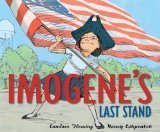Dawn Little's Blog, page 18
July 11, 2011
Two Bobbies by Kirby Larson and Mary Nethery
Recommended Grades: 2-5
Two Bobbies: A True Story of Hurricane Katrina, Friendship, and Survival is the true story of Hurricane Katrina, friendship, and survival. . . of a dog and cat. Bobbi and Bob Cat are left behind when the hurricane hits. Never leaving each other's sides, they overcome many obstacles, living on the streets of New Orleans for four months before being rescued. With a surprise twist, this is a true tale of the power of friendship.
is the true story of Hurricane Katrina, friendship, and survival. . . of a dog and cat. Bobbi and Bob Cat are left behind when the hurricane hits. Never leaving each other's sides, they overcome many obstacles, living on the streets of New Orleans for four months before being rescued. With a surprise twist, this is a true tale of the power of friendship.
Lesson idea:
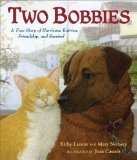

Building Community: Read aloud this book in the first month of school as you work to build your classroom community. Discuss how the two Bobbies worked together to overcome adversity. Compare how the greater community came together to assist the people and pets of New Orleans after Katrina and how the classroom community can work together to have a successful year. Discuss other literary dynamic duos (real or fictional) that demonstrate the power of friendship and create a class list of models that students can turn to (or you can read aloud) as you all work to build a classroom community.
Click here to find more resources on building a classroom community.
©2011 by Dawn Little for Picture This! Teaching with Picture Books. All Amazon links are affiliate links and may result in my receiving a small commission. This is at no additional cost to you.
Filed under: building community, Friendship, teaching with picture books, Two Bobbies by Kirby Larson and Mary Nethery Tagged: building classroom community, friendship, Hurricane Katrina, Two Bobbies by Kirby Larson and Mary Nethery








July 4, 2011
Imogene's Last Stand by Candace Fleming
On this 4th of July, a special history/America inspired post:
Recommended Grades: 2-5
Imogene's Last Stand is the story of Imogene Tripp, a young girl with a passion for history (she even recites famous quotes). So when the mayor decides to tear down the Liddleville Historical Society to make way for a shoelace factory, Imogene must fight for the town's past. Is she able to save history?
is the story of Imogene Tripp, a young girl with a passion for history (she even recites famous quotes). So when the mayor decides to tear down the Liddleville Historical Society to make way for a shoelace factory, Imogene must fight for the town's past. Is she able to save history?
Making Predictions: Prior to reading aloud the book, ask students to make predictions based on the title and the cover. As you read aloud, stop and confirm predictions and make more. Predict whether Imogene will be successful in her effort to stop the demolition of the Liddleville Historical Society.
Writers Workshop/Using Famous Quotes: The author used many famous quotes from historical figures and weaved them throughout the story. After you read aloud, ask students to pull out the quotes to put on a quotation wall where you can continue to add quotes, both famous and not so famous. As students work on writing pieces, encourage them to use the quote wall to inspire their writing. Perhaps they want to weave quotes into their own writing, or perhaps a quote is just the spark that inspires their next writing piece. You could even pair this book with Pop! The Invention of Bubble Gum as a model of weaving quotes into narrative or informational texts.
©2011 by Dawn Little for Picture This! Teaching with Picture Books. All Amazon links are affiliate links and may result in my receiving a small commission. This is at no additional cost to you.
Filed under: Famous Quotes, Imogene's Last Stand by Candace Fleming, Making Predictions, teaching with picture books, writers workshop Tagged: famous quotations, Imogene's Last Stand, Making Predictions, writers workshop








June 29, 2011
Pop! The Invention of Bubble Gum by Meghan McCarthy
Recommended Grades: 2-5


Pop!: The Invention of Bubble Gum follows Walter Diemer's attempts and success of the invention of Dubble Bubble bubble gum. The pictures are bright and colorful and full of gumballs. The back of the book has a nice layout of further information about Walter Diemer and the history of gum.
follows Walter Diemer's attempts and success of the invention of Dubble Bubble bubble gum. The pictures are bright and colorful and full of gumballs. The back of the book has a nice layout of further information about Walter Diemer and the history of gum.
Lesson idea: I envision this as a fun read aloud that can also be used as a mentor text in Writer's Workshop. Read aloud the book and discuss the organization of the information. How does the author take factual information and transform it into a picture book? Note how she uses actual quotes from the inventor and creates a layout at the end of the book that shares further information about Walter Diemer and gum. Use this book as a mentor text for a form of report writing. Find similar models to read aloud and use as mentor texts as well. Then, instead of asking students to write reports on a topic, ask them to write a picture book that weaves factual information and quotes from their research. Students could even create a similar layout at the end of their picture book that provides further information and research.
©2011 by Dawn Little for Picture This! Teaching with Picture Books. All Amazon links are affiliate links and may result in my receiving a small commission. This is at no additional cost to you.
Filed under: nonfiction, Pop! The Invention of Bubble Gum, teaching with picture books, writers workshop Tagged: invention of bubble gum, Pop! The Invention of Bubble Gum by Megan McCarthy, writers workshop








June 20, 2011
Weslandia by Paul Fleischman
Recommended Grades: 2-5
Wesley, a somewhat different child whom nobody will play with at school, decides to make a summer project. His project consists of creating his own language and backyard civilization. Will the other kids come around and become friendly, or will they continue to think he's different?
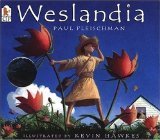


Lesson idea: This book has many instructional opportunities. One way Weslandia can be useful in the classroom is to
can be useful in the classroom is to model asking questions. The book can be extremely confusing to students and I think monitoring comprehension through questions is one great way to use the book. This can be done though a classroom chart labeled, Questions Before Reading, Questions During Reading, and Questions After Reading. As you read aloud the book, ask students to indicate when they have questions. Write their questions in the appropriate column in the class chart. Later, go through the questions and determine if they can be answered directly from the text. If not, re-read the text to the class and determine if the questions may supply an opportunity to model making inferences. This lesson is extremely multi-layered and could take several days to complete.
model asking questions. The book can be extremely confusing to students and I think monitoring comprehension through questions is one great way to use the book. This can be done though a classroom chart labeled, Questions Before Reading, Questions During Reading, and Questions After Reading. As you read aloud the book, ask students to indicate when they have questions. Write their questions in the appropriate column in the class chart. Later, go through the questions and determine if they can be answered directly from the text. If not, re-read the text to the class and determine if the questions may supply an opportunity to model making inferences. This lesson is extremely multi-layered and could take several days to complete.
©2011 by Dawn Little for Picture This! Teaching with Picture Books. All Amazon links are affiliate links and may result in my receiving a small commission. This is at no additional cost to you.
Filed under: asking questions, monitoring comprehension, teaching with picture books, Weslandia by Paul Fleischman Tagged: asking questions, monitoring comprehension, weslandia by Paul Fleischman








June 13, 2011
Last Day Blues by Julie Danneberg
Recommended Grades: 2-5
It's the end of the school year and in Last Day Blues , Mrs. Sarah Jane Hartwell is finding it hard to say goodbye to her class. The class comes up with a plan to make sure she won't be sad and miss them. But the teachers have plans of their own.
, Mrs. Sarah Jane Hartwell is finding it hard to say goodbye to her class. The class comes up with a plan to make sure she won't be sad and miss them. But the teachers have plans of their own.
Lesson idea: Your school year may have already ended, but some are not ending until this week or later. Read aloud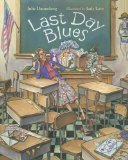 this book as an end of the year "goodbye" to students. Ask students to write one sentence or one paragraph explaining one or more things they may miss about school, their class, their teachers, or their classmates. Perhaps, you may want to write a sentence or a paragraph as well explaining what you will miss.
this book as an end of the year "goodbye" to students. Ask students to write one sentence or one paragraph explaining one or more things they may miss about school, their class, their teachers, or their classmates. Perhaps, you may want to write a sentence or a paragraph as well explaining what you will miss.
©2011 by Dawn Little for Picture This! Teaching with Picture Books. All Amazon links are affiliate links and may result in my receiving a small commission. This is at no additional cost to you.
Filed under: Last Day Blues by Julie Danneberg Tagged: end of year literacy activities, Last Day Blues








June 6, 2011
Dear Deer: A Book of Homophones by Gene Barretta
Recommended Grades: 3-5
Word Choice
Dear Deer: A Book of Homophones is a book of homophones and some homonyms. Aunt Ant has just moved to the
is a book of homophones and some homonyms. Aunt Ant has just moved to the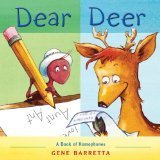 zoo and describes all the animal behavior she sees in a letter to her dear deer, in homophones.
zoo and describes all the animal behavior she sees in a letter to her dear deer, in homophones.
Lesson idea: Read aloud this book and discuss the differences between homophones and homonyms (the author makes note of this at the beginning of the book). With the whole class, create a list of homophones (begin with the homophones in the book) in a two column chart. Add to the chart as other homophones become noticed throughout the year. Often, children will confuse the spelling of words that are homophones. Sporadically, have students edit a partner's writing piece for the use of homophones correctly.
**Note** I provide these lesson ideas under the assumption that you are familiar with The Six Traits of Writing. If you are not, and would like more information on teaching students about sentence fluency or any other six traits component, please feel free to contact me at Dlittle[at]linkstoliteracy[dot]com. I am happy to provide more specific lessons or resources if necessary.
©2011 by Dawn Little for Picture This! Teaching with Picture Books. All Amazon links are affiliate links and may result in my receiving a small commission. This is at no additional cost to you.
Filed under: Dear Deer by Gene Barretta, six traits of writing, teaching with picture books, word choice, writers workshop Tagged: Dear Deer by Gene Barretta, six traits of writing, teaching word choice, writers workshop








May 30, 2011
The Web Files by Margie Palatini
May Theme: Conventions
For the first half of 2011, I will take time to focus on picture books that you can use with each of the Six Traits of Writing. Each month will be dedicated to a new trait.
December 2010 – Ideas
January 2011 – Organization
February 2011 – Voice
March 2011 – Word Choice
April 2011 – Sentence Fluency
This month's theme is Conventions. What would a copy editor need to do to prepare the piece for publication?
Recommended Grades: 3-5
Web Files, The is the story of two Ducktectives trying to solve a case. Ducktective Web and his partner, Bill, have
is the story of two Ducktectives trying to solve a case. Ducktective Web and his partner, Bill, have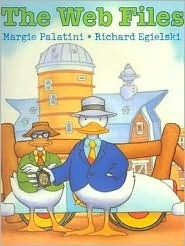 been called to the farm. All of the vegetables are vanishing! Will they be able to find the culprit and solve the mystery?
been called to the farm. All of the vegetables are vanishing! Will they be able to find the culprit and solve the mystery?
Note: This is one of my favorite resources to use to model the use of conventions to students. This was originally posted on Picture This! Teaching with Picture Books on May 18, 2009.
Lesson idea: Read the book aloud once to your students. Discuss what would happen if the book did not have conventions. Provide an excerpt of the book with the punctuation marks removed as a model for the whole class. Read each sentence and think aloud for the students as you determine the punctuation marks that are necessary. After, provide another excerpt with the punctuation marks removed for the students to work on with a partner. Eventually, have students edit writing pieces for missing conventions.
**Note** I provide these lesson ideas under the assumption that you are familiar with The Six Traits of Writing. If you are not, and would like more information on teaching students about sentence fluency or any other six traits component, please feel free to contact me at Dlittle[at]linkstoliteracy[dot]com. I am happy to provide more specific lessons or resources if necessary.
©2011 by Dawn Little for Picture This! Teaching with Picture Books. All Amazon links are affiliate links and may result in my receiving a small commission. This is at no additional cost to you.
Filed under: conventions, six traits of writing, teaching with picture books, The Web Files, writers workshop Tagged: conventions, six traits of writing, The Web Files, writers workshop








May 23, 2011
The Girl's Like Spaghetti: Why, You Can't Manage without Apostrophes by Lynne Truss
May Theme: Conventions
For the first half of 2011, I will take time to focus on picture books that you can use with each of the Six Traits of Writing. Each month will be dedicated to a new trait.
December 2010 – Ideas
January 2011 – Organization
February 2011 – Voice
March 2011 – Word Choice
April 2011 – Sentence Fluency
This month's theme is Conventions. What would a copy editor need to do to prepare the piece for publication?
Recommended Grades: 3-5
The Girl's Like Spaghetti: Why, You Can't Manage without Apostrophes! is part of a series of books on conventions
is part of a series of books on conventions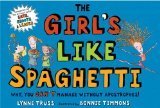 (see last week's post). This particular book is specifically about the use of apostrophes and how apostrophes change meaning depending on whether they are placed in a sentence. A fun read that will often make kids laugh out loud.
(see last week's post). This particular book is specifically about the use of apostrophes and how apostrophes change meaning depending on whether they are placed in a sentence. A fun read that will often make kids laugh out loud.
Lesson idea: Read aloud this book and discuss the use of apostrophes. Model how to determine where to put an apostrophe in several sentences that you provide. Have students write their own set of sentences that need apostrophes. Have them switch with a partner and edit the sentences for apostrophes. Have students independently write and illustrate sentence pairs placing the apostrophe or removing it to change the meaning. Compile all student sentence pairs into a class book to place in your writing center as a resource for editing.
**Note** I provide these lesson ideas under the assumption that you are familiar with The Six Traits of Writing. If you are not, and would like more information on teaching students about sentence fluency or any other six traits component, please feel free to contact me at Dlittle[at]linkstoliteracy[dot]com. I am happy to provide more specific lessons or resources if necessary.
©2011 by Dawn Little for Picture This! Teaching with Picture Books. All Amazon links are affiliate links and may result in my receiving a small commission. This is at no additional cost to you.
Filed under: conventions, six traits of writing, teaching with picture books, The Girl's Like Spaghetti, writers workshop Tagged: conventions, six traits of writing, The Girl's Like Spaghetti, writers workshop








May 16, 2011
Eats, Shoots & Leaves: Why, Commas Really Do Make a Difference! by Lynne Truss
May Theme: Conventions
For the first half of 2011, I will take time to focus on picture books that you can use with each of the Six Traits of Writing. Each month will be dedicated to a new trait.
December 2010 – Ideas
January 2011 – Organization
February 2011 – Voice
March 2011 – Word Choice
April 2011 – Sentence Fluency
This month's theme is Conventions. What would a copy editor need to do to prepare the piece for publication?
Recommended Grades: 3-5
Eats, Shoots & Leaves: Why, Commas Really Do Make a Difference! is part of a series of books on conventions. This
is part of a series of books on conventions. This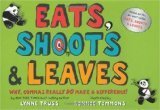 particular book is specifically about the use of commas and how commas change meaning depending on their placement in a sentence. A fun read that will often make kids laugh out loud.
particular book is specifically about the use of commas and how commas change meaning depending on their placement in a sentence. A fun read that will often make kids laugh out loud.
Lesson idea: Read aloud this book and discuss the use and placement of commas. Model how to determine where to put a comma in several sentences that you provide. Have students write their own set of sentences that need a comma. Have them switch with a partner and edit the sentences for commas. Have students independently write and illustrate sentence pairs moving the comma to change the meaning. Compile all student sentence pairs into a class book to place in your writing center as a resource for editing.
**Note** I provide these lesson ideas under the assumption that you are familiar with The Six Traits of Writing. If you are not, and would like more information on teaching students about sentence fluency or any other six traits component, please feel free to contact me at Dlittle[at]linkstoliteracy[dot]com. I am happy to provide more specific lessons or resources if necessary.
©2011 by Dawn Little for Picture This! Teaching with Picture Books. All Amazon links are affiliate links and may result in my receiving a small commission. This is at no additional cost to you.
Filed under: conventions, Shoots & Leaves by Lynne Truss, six traits of writing, teaching with picture books, writers workshop Tagged: conventions, Eats Shoots & Leaves, six traits of writing, writers workshop








May 9, 2011
Punctuation Takes a Vacation by Robin Pulver
May Theme: Conventions
For the first half of 2011, I will take time to focus on picture books that you can use with each of the Six Traits of Writing. Each month will be dedicated to a new trait.
December 2010 – Ideas
January 2011 – Organization
February 2011 – Voice
March 2011 – Word Choice
April 2011 – Sentence Fluency
This month's theme is Conventions. What would a copy editor need to do to prepare the piece for publication?
Recommended Grades: 3-5
Punctuation Takes a Vacation is the companion book to Nouns and Verbs Have a Field Day. In this book,
punctuation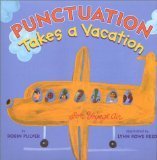 takes a vacation and the students can't read anything properly. The students realize how important punctuation is and asks them to return. But, will they return or stay on vacation?
takes a vacation and the students can't read anything properly. The students realize how important punctuation is and asks them to return. But, will they return or stay on vacation?
Lesson idea: Read aloud this book and discuss the purpose of the specific punctuation used in the book. Find a paragraph in a well-known book and retype it, removing the punctuation. Present it for the whole class to see and think aloud as you model how to determine what punctuation is missing and how you would fix it. Then provide students with the opportunity to do the same. Have students take a paragraph from a book they are reading and re-type it without punctuation. Then they should trade with a partner and both students should determine which punctuation is missing. Eventually have students edit a partner's writing piece for missing punctuation.
**Note** I provide these lesson ideas under the assumption that you are familiar with The Six Traits of Writing. If you are not, and would like more information on teaching students about sentence fluency or any other six traits component, please feel free to contact me at Dlittle[at]linkstoliteracy[dot]com. I am happy to provide more specific lessons or resources if necessary.
©2011 by Dawn Little for Picture This! Teaching with Picture Books. All Amazon links are affiliate links and may result in my receiving a small commission. This is at no additional cost to you.
Filed under: conventions, six traits of writing, writers workshop Tagged: conventions, Punctuation Takes a Vacation by Robin Pulver, six traits of writing, writers workshop









